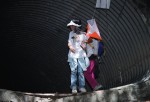Morgan Territory Regional Preserve
Date: (Sun.) Feb. 12, 2017
Location: Livermore, CA
Event Directors: - 925.516.7622, - 650.404.7037
Course Setters: Daniel Å ebo, Matej Sebo
Type: B; Regular 7-course event at one of our most popular venues
Course Setters' Notes
By Matej Å ebo
Important Event-Day Information
There will be one, remote start location for all the courses. It is located 1.5 km (real, not straight-line distance) from the registration area. The route to the Start is along park trails and will be clearly marked with pin flags. It will take about 15–20 minutes of walking to reach this location.
There will also be a single common finish location for all the courses; it will be very close to the registration area.
Map Comments
The Morgan Territory map, revised and updated for the U.S. Champs in 2016, is one of our club's finest. It is printed at a scale of 1:10,000 for all courses. The contour interval is 5 meters.
Most of the park is either open land (mapped orange) or open forest (mapped white). Vegetation boundaries are usually distinct and well-mapped.
Light- and medium-green areas are progressively slower than open forest, but still passable. Areas mapped as dark green are mostly manzanita or chaparral thickets (although they are sometimes massive poison oak bushes). It is a good idea to plan routes around these, as they are usually impenetrable.
Just about all rock features are accurately mapped, although they have been generalized in some places. Most mapped boulders are over 1 meter high. Stony ground consists of scattered rocks less than 1 meter high. Areas where multiple boulders (1 meter high) occur close together are mapped as boulder fields.
Lone trees are mapped with the hollow, green, circle symbol. Green ×'s are dead trees that are still standing or dead, fallen trees (the map does not distinguish between these). On the control description sheet, fallen trees are marked with the rootstock symbol, and standing dead trees are marked with the "tree, ruined" symbol.
Due to the recent rains, you will probably encounter fresh erosion features and fallen trees that have not yet been mapped.
Hazards
Poison oak is present, and the courses have been designed to avoid the worst areas. However, many of the rocky areas in the park contain sparse, low clumps of poison oak twigs. Most of these are easily avoided if you recognize them. Long pants are recommended, as is washing with cold water and soap (or Tecnu) after the event.
Ticks might be present, so check your clothing and skin after you return from your course.
Footing can be slippery, especially if there is rain in the days leading up to the event. Shoes with good grip are advised, especially for competitors on Orange, Brown, Green, Red, or Blue.
Participants on the Red and Blue courses will have to cross one or more barbed-wire fences. Crawling underneath the lowest, loose wire is recommended. Gates are indicated with the black crossing-point symbol.
There are a lot of cows in the park, but they are generally docile if not antagonized. Please be careful not to come between a mother cow and her calf.
Although this is technically not a hazard, we would also like to remind all runners to carefully read the map when approaching a control. In some areas of the park, controls have been placed very close together. The standard IOF rules for minimum distances between controls have been followed (30 meters apart if on different features, 60 m apart if on similar features). Remember that not all of the controls you see will be on your course, so remember to check each control code before punching.
Course Statistics
Water Navigational Physical
Course Distance Climb Controls stops Difficulty Difficulty
White 3.0 km 90 m 12 0 Very easy Easy
Yellow 3.2 km 90 m 9 1 Easy Easy
Orange 5.3 km 170 m 14 2 Moderate Moderate
Brown 3.7 km 130 m 15 1 Difficult Easy
Green 5.4 km 210 m 22 2 Difficult Moderate
Red 7.1 km 320 m 28 3 Difficult Difficult
Blue 8.8 km 375 m 30 3 Difficult Very difficult
Although there will be water stops on all of the intermediate and advanced courses, carrying water is recommended, especially if you are starting later in the day or expect to be on your course a long time.
The course distances are measured along the straight lines between controls—your actual distance will be longer. Climb is measured along the optimal route (in the course setter's opinion)—your actual climb may be less or more, depending on your route choices.
Special Notes for Advanced Courses
Advanced courses (Brown, Green, Red, and Blue) at Morgan Territory are typically more navigationally challenging than at most other Bay Area parks. Be prepared for both route-choice problems and fine navigation involving many different orienteering techniques. I have tried to make the courses as varied and exciting as possible.
The Green, Red, and Blue courses will each contain a phi loop. An example of a phi loop is shown in this file (PDF/6KB). In the example, the runner would first punch control #15, then visit #16 and #17, then go back to #15 (now labeled as #18), then go to #19, visit #17 again (now #20), and then go to #21 and continue with their course. It is important to visit these controls (and all others, of course) exactly in the order shown on the map.

